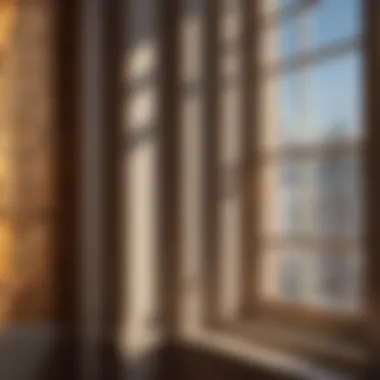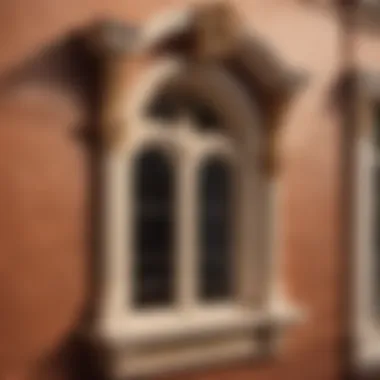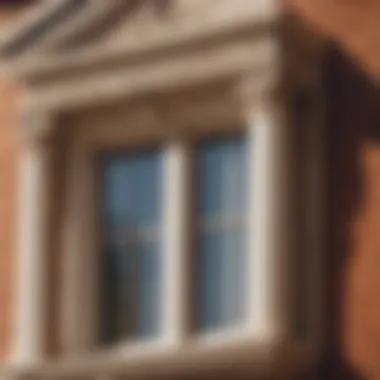Materials:
- Exterior window moulding strips: 10 pieces of PVC moulding, each measuring 8 feet in length and 4 inches in width.
- Caulk: 1 tube of exterior-grade caulk
- Nails: 1 box of stainless steel finishing nails
- Primer: 1 gallon of exterior primer
- Paint: 2 gallons of high-quality exterior paint
- Sandpaper: 1 pack of sandpaper with grit sizes of 80 and 120
DIY Steps:
-
Preparing the Surface: Start by ensuring the window area is clean and dry. Sand any rough spots on the existing moulding to create a smooth surface for the new moulding.
-
Measuring and Cutting: Measure the dimensions of each window frame and cut the PVC moulding strips accordingly using a saw to achieve precise fits.
-
Priming and Painting: Apply a coat of exterior primer to all sides of the moulding strips. Once dried, paint them with the chosen exterior paint color, allowing sufficient drying time between coats.
Technical Aspects:
- Tools Needed: Saw, measuring tape, paintbrushes, hammer, caulk gun
- Timing Specifics: Allow 24 hours for the primer to dry completely before painting. Each coat of paint should dry for at least 12 hours.
- Critical Techniques: Ensure proper alignment and spacing of the moulding strips for a polished finish.
DIY Project Process:


-
Installation Method: Begin by attaching the moulding strips around the window frame using stainless steel nails. Apply a thin bead of caulk along the edges for added sealing.
-
Key Techniques: Press the moulding firmly against the frame to secure it in place. Use a level to ensure straight alignment during installation.
-
Timings: Allow the caulk to dry for 24 hours before applying a touch-up coat of paint if needed.
Troubleshooting Tips:


- Gap Filling: If gaps appear between the moulding and window frame, reapply caulk to seal them effectively.
- Paint Imperfections: Sand down any visible paint imperfections and apply an additional coat for a flawless finish.
Introduction to Exterior Window Moulding


In this comprehensive guide focusing on the intricacies of exterior window moulding, it becomes evident that this element plays a pivotal role in architectural design. Exterior window moulding serves not only as an aesthetic enhancement but also as a practical solution for various functional needs. From enhancing the overall curb appeal of a structure to providing weatherproofing benefits and adding intricate architectural details, the importance of exterior window moulding cannot be overstated. As homeowners seek to create a harmonious blend of style and functionality in their living spaces, understanding the significance of exterior window moulding becomes essential.
Historical Evolution of Window Moulding
Ancient Influences
Exploring the historical evolution of window moulding unveils the influence of ancient civilizations on this architectural element. Ancient influences, characterized by intricate patterns and ornate detailing, have paved the way for the design aesthetics we observe today. Despite the passage of time, the timeless appeal of ancient influences remains popular due to their ability to add a touch of sophistication and cultural richness to exterior window moulding. While the intricacy of ancient influences may require additional maintenance, the unique charm they bring to a property is unparalleled.
Renaissance Revival
The Renaissance Revival period introduced a fusion of classical architectural elements with innovative design concepts. Known for its symmetry and grandeur, Renaissance Revival window moulding embodies a sense of elegance and refinement. Drawing inspiration from the art and culture of the Renaissance era, this style choice exudes a timeless allure that appeals to those seeking a sophisticated touch for their exterior window treatments. However, the elaborate nature of Renaissance Revival moulding may necessitate careful upkeep to maintain its original beauty.
Victorian Era Elegance
During the Victorian era, window moulding took on a new level of opulence and sophistication. Victorian Era Elegance is characterized by intricate carvings, elaborate motifs, and rich detailing, showcasing the craftsmanship of the period. This style choice adds a sense of nostalgia and grandeur to exterior window moulding, making it a popular option for those looking to evoke a sense of historical charm. While the ornate nature of Victorian Era Elegance can be visually stunning, proper maintenance and periodic restoration are essential to preserve its intricate features.
Importance of Exterior Window Moulding
Enhancing Curb Appeal
Enhancing curb appeal through the strategic use of exterior window moulding can transform the overall look of a property. By selecting the right style and design elements, homeowners can create a visual impact that captivates onlookers and elevates the architectural aesthetics of their home. From classic to contemporary styles, the versatility of exterior window moulding in enhancing curb appeal is unparalleled, making it a valuable asset in the realm of home design.
Adding Architectural Detail
Adding architectural detail through exterior window moulding allows homeowners to infuse character and personality into their living spaces. Whether opting for intricate patterns or simple yet elegant designs, window moulding provides an opportunity to showcase craftsmanship and attention to detail. The addition of architectural detail not only enhances the visual appeal of a structure but also contributes to a sense of individuality and uniqueness that sets the property apart.
Weatherproofing Benefits
Beyond its aesthetic value, exterior window moulding offers practical benefits in terms of weatherproofing. By providing a protective barrier against the elements, such as rain, wind, and sunlight, window moulding helps safeguard the structural integrity of a building. Incorporating weatherproofing features into the design of exterior moulding ensures long-term durability and functionality, helping homeowners mitigate potential damage and maintenance costs.
Common Materials Used
Wood
Wood remains a popular choice for exterior window moulding due to its natural beauty and versatility. With a wide range of wood species available, homeowners can select options that best complement their architectural style and personal preferences. While wood offers a classic aesthetic appeal, proper maintenance, including sealing and painting, is essential to prevent rot and decay over time.
Vinyl
Vinyl window moulding has gained popularity for its affordability and low maintenance requirements. Resistant to moisture and insects, vinyl moulding offers durability and long-lasting performance in various environmental conditions. The ease of installation and cleaning makes vinyl a practical choice for homeowners seeking a cost-effective solution without compromising on quality.
Fiberglass
Fiberglass window moulding combines strength with versatility, making it a preferred option for modern residential properties. Resistant to warping, rot, and insects, fiberglass moulding offers superior durability and low maintenance requirements. Its smooth finish and ability to mimic the look of wood make it a popular choice for homeowners looking for a high-performance material that requires minimal upkeep.
Composite
Composite window moulding blends the advantages of different materials, such as wood fibers and polymers, to create a versatile and durable option. Offering the aesthetic appeal of wood with the low maintenance benefits of synthetic materials, composite moulding provides an ideal balance of style and functionality. Its resistance to moisture and rot makes it a sustainable choice for environmentally conscious homeowners seeking a long-lasting solution for their exterior window treatments.
Styles and Designs of Exterior Window Moulding
Exterior window moulding plays a crucial role in the architectural aesthetics of a home, adding visual interest, depth, and character to the facade. Understanding the different styles and designs of exterior window moulding can help homeowners make informed decisions that complement their home's overall design theme. By exploring traditional and contemporary styles, individuals can tailor the look of their windows to suit their personal preferences and architectural style. Factors such as material, shape, and detailing all come into play when choosing the right window moulding design.
Traditional vs. Contemporary Styles
When it comes to the styles of exterior window moulding, there is a diverse range of options available, from timeless traditional designs to sleek contemporary styles. Traditional designs, such as Colonial Revival, offer a sense of historical charm and elegance, perfect for those looking to preserve the classic architectural features of their home. On the other hand, contemporary styles like Modern Minimalism focus on clean lines, simplicity, and a minimalist aesthetic, ideal for those seeking a more modern and streamlined look for their windows.
Colonial Revival
Colonial Revival style is known for its emphasis on symmetrical shapes, intricate detailing, and historical references to colonial architecture. This style evokes a sense of tradition and sophistication, making it a popular choice for traditional homes and historic properties. The key characteristic of Colonial Revival window moulding is its ornate trim work, often featuring decorative elements like dentil molding, rosettes, and fluting. While Colonial Revival adds timeless elegance to a home, it may require more maintenance due to its intricate detailing compared to simpler designs.
Craftsman Style
Craftsman style window moulding pays homage to the Arts and Crafts movement, emphasizing quality craftsmanship, natural materials, and handcrafted details. This style is characterized by its emphasis on simplicity, geometric shapes, and exposed joinery, exuding a sense of warmth and craftsmanship. Craftsman style window moulding often features flat casing, thick trim, and subtle detailing, giving it a handmade and artisanal look. While Craftsman style offers a sense of authenticity and craftsmanship, it may not suit every architectural style and can feel out of place in modern or contemporary homes.
Modern Minimalism
Modern Minimalism embraces clean lines, geometric shapes, and a less-is-more approach to design. This style focuses on simplicity, functionality, and the use of industrial materials like metal and concrete. Modern Minimalism window moulding is characterized by its sleek profile, absence of ornamentation, and emphasis on minimalist aesthetics. The key feature of Modern Minimalism is its understated elegance and contemporary appeal, making it a popular choice for minimalist and modern homes. While Modern Minimalism offers a clean and contemporary look, it may lack the ornate details and historical charm found in traditional styles.
Geometric Shapes and Patterns
When it comes to window moulding, the use of geometric shapes and patterns can add visual interest and architectural detail to a home's exterior. Whether opting for rectangular moulding, arched designs, or circular accents, homeowners can elevate the look of their windows by incorporating unique geometric elements.
Rectangular Moulding
Rectangular moulding offers a classic and versatile option for window trim, providing a clean and understated look that complements a wide range of architectural styles. The key characteristic of rectangular moulding is its simplicity and straight lines, making it a timeless choice for both traditional and contemporary homes. One of the advantages of rectangular moulding is its ease of installation and compatibility with various window shapes and sizes. However, due to its simplicity, rectangular moulding may lack the ornate detailing and visual interest found in more intricate designs.
Arched Designs
Arched designs bring a touch of elegance and sophistication to window moulding, adding a sense of architectural drama and visual appeal to a home's facade. The key characteristic of arched designs is their graceful curves and arches, creating a sense of verticality and grandeur. Arched window moulding is ideal for homes with architectural elements like arched windows or doorways, enhancing the overall continuity and harmony of the design. One of the advantages of arched designs is their ability to create a focal point and add a sense of architectural interest to an otherwise plain facade. However, arched designs may require custom fabrication and installation, making them more costly and labor-intensive compared to standard moulding options.
Circular Accents
Circular accents offer a unique and eye-catching option for window moulding, introducing a playful and unexpected element to a home's exterior. The key characteristic of circular accents is their whimsical shapes and organic forms, creating a sense of movement and fluidity in the design. Circular window moulding can add a touch of charm and personality to a home, making it stand out from traditional rectangular or arched designs. One of the advantages of circular accents is their ability to infuse a sense of creativity and individuality into a home's architectural style. However, due to their non-standard shapes, circular accents may require custom design and fabrication, adding complexity and cost to the installation process.
Installation and Maintenance of Exterior Window Moulding
Exterior window moulding plays a crucial role in enhancing the aesthetic appeal and functionality of a home. In this section, we will delve into the significance of proper installation and maintenance practices related to exterior window moulding. Ensuring correct installation techniques and consistent upkeep not only prolongs the life of the moulding but also contributes to the overall appearance and durability of the windows.
Proper Installation Techniques
When it comes to installing exterior window moulding, precision is key. Measuring and Cutting are fundamental steps that demand accuracy and attention to detail. The measurements must be spot-on to ensure a seamless fit while cutting should be done meticulously to achieve clean edges and corners. Using high-quality tools for this step is essential to achieve a professional finish. Proper Securing of the Moulding follows measuring and cutting. Securely fastening the moulding using suitable techniques and materials guarantees its stability and longevity. Different types of moulding may require specific securing methods, so understanding these nuances is crucial. Sealing and Caulking cap off the installation process by providing weatherproofing and insulation benefits. The sealing process fills any gaps or joints, preventing water infiltration and enhancing the moulding's durability against external elements.
Tips for Maintenance and Care
Maintenance is key to preserving the condition and visual appeal of exterior window moulding. Regular Painting not only refreshes the appearance but also serves as a protective layer against external elements. High-quality paints and proper application techniques are vital for long-lasting results. Inspecting for Damage on a routine basis helps identify early signs of wear or damage, allowing for timely repairs and preventing further deterioration. When it comes to Repairing Rot or Decay, swift action is necessary to prevent structural issues. Understanding the root cause of the rot or decay and employing appropriate repair methods are essential for restoring the moulding's integrity and aesthetics.
Trends and Innovations in Exterior Window Moulding
In the realm of exterior window moulding, staying abreast of the latest trends and innovations is paramount. This section focuses on the cutting-edge developments that are shaping the future of window aesthetics and functionality. Understanding the significance of trends and innovations in exterior window moulding is crucial for homeowners and designers alike, as it not only enhances the visual appeal of a property but also contributes to its overall energy efficiency and sustainability.
Sustainable Materials and Eco-Friendly Options
Recycled Wood Composite
Delving into the realm of sustainable materials, Recycled Wood Composite emerges as a frontrunner in the quest for eco-friendly window moulding solutions. This innovative material stands out for its unique blend of recycled wood fibers and composite materials, combining durability with environmental consciousness. The key characteristic of Recycled Wood Composite lies in its ability to mimic the look of natural wood while offering enhanced resistance to moisture, rot, and insect damage. Homeowners opting for Recycled Wood Composite can revel in the fact that they are not only beautifying their property but also making an environmentally responsible choice.
Energy-Efficient Designs
Energy-efficient designs are revolutionizing the world of exterior window moulding by prioritizing sustainability and cost-effectiveness. These designs are crafted with the goal of minimizing heat loss and maximizing natural light intake, ultimately reducing energy consumption within a home. The standout feature of Energy-Efficient Designs lies in their ability to provide thermal insulation, keeping interiors comfortable year-round while lowering utility bills. While these designs usher in a host of benefits such as reduced carbon footprint and enhanced comfort, it is essential to weigh the initial investment against long-term energy savings to make an informed decision.
Smart Technology Integration
Automated Shading Systems
Integrating automated shading systems into exterior window moulding brings forth a new era of convenience and efficiency. These systems, equipped with sensors and timers, can adjust shading levels based on sunlight intensity and time of day, optimizing energy efficiency and indoor comfort. Automated Shading Systems excel in providing homeowners with effortless control over light exposure and privacy while enhancing overall aesthetic appeal. However, it is vital for users to ensure proper maintenance and occasional manual adjustments to prevent malfunctions and maintain optimal performance.
Remote Control Features
The inclusion of remote control features in window moulding technology ushers in a new realm of convenience and customization for homeowners. With remote control capabilities, users can adjust shading, ventilation, and lighting preferences at the touch of a button, enhancing comfort and ease of use. The key characteristic of Remote Control Features lies in their ability to offer personalized solutions tailored to individual preferences, be it creating the ideal ambiance or improving energy efficiency. While these features epitomize modern living, users must ensure secure connectivity and reliable technology to fully harness their benefits.





